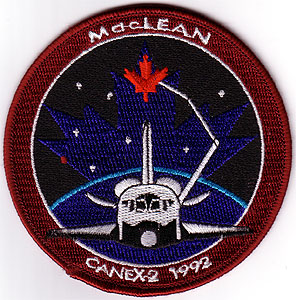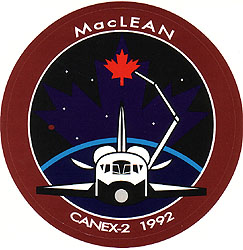

Artwork

The MacLean Mission insignia commemorates and symbolizes all aspects of Canadian participation in Mission STS-52.
The red maple leaf represents Canadian participation in the flight: flight hardware and software were developed in Canada, and Canadian experiments will be performed by a Canadian astronaut. The larger, purple maple leaf rising over the horizon recalls the Northern Lights (Aurora borealis) over Canada. Canada space science beginnings stem from research into the Aurora. The Canadarm (Remote Manipulator System) is shown extending from the shuttle and holding the maple leaf since the Canadarm will be used extensively during the mission in the evaluation of the Canadian Space Vision System (SVS). The Canadarm is also representative of other Canadian hardware aboard, such as the SVS. The SVS is expected to improve the Canadarm's operational performance and may become a permanent part of shuttle operations.
The Earth is shown with a blue hand, symbolizing its fragile atmosphere and the significance of space research into the environment. During the mission, two Canadian experiments will provide data about the upper atmosphere: one investigation will examine data on the night glow phenomena and the other will research the stratosphere with respect to the Earth's protective ozone layer.
The five stars to the left of the tail of the shuttle and the two to the right indicate the mission flight number (52), as well as the number of Canadian experiments to be performed during the mission (5+2=7).
Mars is depicted to the left of the sky, just above the Earth. The research being conducted on this flight will contribute towards future missions to the red planet. Research in materials sciences will help increase our knowledge of how plastics and composite materials used in the construction of spacecraft degrade in the harsh environment of space.
Scientists and engineers will be able to try new protective coatings and test materials designed for use on specific space hardware such as the international Space Station Freedom. The Canadian Space Vision System technology may be used in the future to explore Mars. The life science experiments, which help increase our understanding of the body's adaptation to space flight, will enable humans to prepare for more extended periods in space, such as stints on the Space Station or missions to Mars.